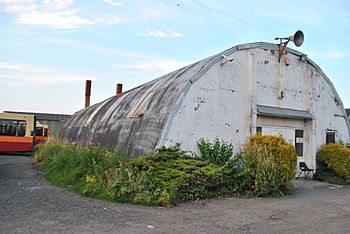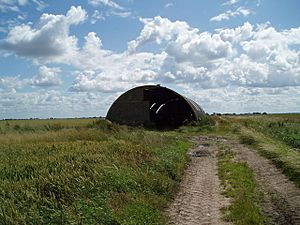Romney hut facts for kids
The Romney hut is a special type of building made from steel. The British military used these huts, especially during World War II. They were designed to be built quickly and easily, like giant LEGO sets!
Contents
Building for War: The Romney Hut Story
When World War II began, the British army needed many buildings, fast! They started making "prefabricated" huts. This means the parts were made in a factory and then put together quickly on site. These new huts were an upgrade from older designs like the Nissen hut.
From Iris to Romney: A Design Upgrade
One early design was called the Iris hut. It was a medium-sized building, about 35 feet wide. It could be made from 60 to 96 feet long, with extra 4-foot sections added if needed. However, the Iris hut had a big problem: its roof was not strong enough. It could not hold the weight of snow! This meant the huts sometimes collapsed after heavy snowfalls. Because of this issue, the Iris hut was replaced by the Romney hut by 1941.
How Romney Huts Were Built and Used
Both the Iris hut and the Romney hut were built with a strong frame of steel tubes. These tubes were clamped together to form the structure. Each hut had an entrance in the middle.
Romney huts were very useful for holding things that needed a lot of space. For example, they were used as large storage areas or workshops. Sometimes, on airfields, two or more Romney huts were put together. This created even bigger spaces, sometimes even used as aircraft hangars!
The Romney hut was invented by Lieutenant Colonel Edgar Frank Brawn. He was an engineer in the Royal Engineers.
See also
- B hut
- Iris hut
- Quonset hut



